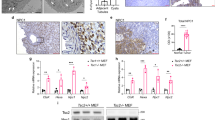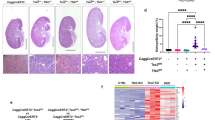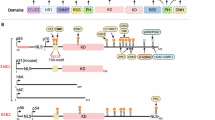Abstract
The mammalian target of rapamycin (mTOR) has a central role in the regulation of cell growth. mTOR receives input from multiple signaling pathways, including growth factors and nutrients, to stimulate protein synthesis by phosphorylating key translation regulators such as ribosomal S6 kinase and eukaryote initiation factor 4E binding protein 1. High levels of dysregulated mTOR activity are associated with several hamartoma syndromes, including tuberous sclerosis complex, the PTEN-related hamartoma syndromes and Peutz-Jeghers syndrome. These disorders are all caused by mutations in tumor-suppressor genes that negatively regulate mTOR. Here we discuss the emerging evidence for a functional relationship between the mTOR signaling pathway and several genetic diseases, and we present evidence supporting a model in which dysregulation of mTOR may be a common molecular basis, not only for hamartoma syndromes, but also for other cellular hypertrophic disorders.
This is a preview of subscription content, access via your institution
Access options
Subscribe to this journal
Receive 12 print issues and online access
$209.00 per year
only $17.42 per issue
Buy this article
- Purchase on Springer Link
- Instant access to full article PDF
Prices may be subject to local taxes which are calculated during checkout


Similar content being viewed by others
References
Heitman, J., Movva, N.R. & Hall, M.N. Targets for cell cycle arrest by the immunosuppressant rapamycin in yeast. Science 253, 905–909 (1991).
Brown, E.J. et al. A mammalian protein targeted by G1-arresting rapamycin-receptor complex. Nature 369, 756–758 (1994).
Chiu, M.I., Katz, H. & Berlin, V. RAPT1, a mammalian homolog of yeast Tor, interacts with the FKBP12/rapamycin complex. Proc. Natl. Acad. Sci. USA 91, 12574–12578 (1994).
Sabatini, D.M., Erdjument-Bromage, H., Lui, M., Tempst, P. & Snyder, S.H. RAFT1: a mammalian protein that binds to FKBP12 in a rapamycin-dependent fashion and is homologous to yeast TORs. Cell 78, 35–43 (1994).
Harris, T.E. & Lawrence, J.C. Jr. TOR signaling. Sci STKE 2003, re15 (2003).
Jacinto, E. & Hall, M.N. Tor signalling in bugs, brain and brawn. Nat. Rev. Mol. Cell Biol. 4, 117–126 (2003).
Sarbassov dos, D. et al. Rictor, a novel binding partner of mTOR, defines a rapamycin-insensitive and raptor-independent pathway that regulates the cytoskeleton. Curr. Biol. 14, 1296–1302 (2004).
Hara, K. et al. Raptor, a binding partner of target of rapamycin (TOR), mediates TOR action. Cell 110, 177–189 (2002).
Kim, D.H. et al. mTOR interacts with raptor to form a nutrient-sensitive complex that signals to the cell growth machinery. Cell 110, 163–175 (2002).
Loewith, R. et al. Two TOR complexes, only one of which is rapamycin sensitive, have distinct roles in cell growth control. Mol. Cell 10, 457–468 (2002).
Avruch, J., Belham, C., Weng, Q., Hara, K. & Yonezawa, K. The p70 S6 kinase integrates nutrient and growth signals to control translational capacity. Prog. Mol. Subcell. Biol. 26, 115–154 (2001).
Meyuhas, O. Synthesis of the translational apparatus is regulated at the translational level. Eur. J. Biochem. 267, 6321–6330 (2000).
Gingras, A.C., Raught, B. & Sonenberg, N. eIF4 initiation factors: effectors of mRNA recruitment to ribosomes and regulators of translation. Annu. Rev. Biochem. 68, 913–963 (1999).
Mamane, Y. et al. eIF4E--from translation to transformation. Oncogene 23, 3172–3179 (2004).
Fingar, D.C. et al. mTOR controls cell cycle progression through its cell growth effectors S6K1 and 4E-BP1/eukaryotic translation initiation factor 4E. Mol. Cell. Biol. 24, 200–216 (2004).
Potter, C.J., Huang, H. & Xu, T. Drosophila Tsc1 functions with Tsc2 to antagonize insulin signaling in regulating cell growth, cell proliferation, and organ size. Cell 105, 357–368 (2001).
Tapon, N., Ito, N., Dickson, B.J., Treisman, J.E. & Hariharan, I.K. The Drosophila tuberous sclerosis complex gene homologs restrict cell growth and cell proliferation. Cell 105, 345–355 (2001).
Gao, X. & Pan, D. TSC1 and TSC2 tumor suppressors antagonize insulin signaling in cell growth. Genes Dev. 15, 1383–1392 (2001).
Stocker, H. et al. Rheb is an essential regulator of S6K in controlling cell growth in Drosophila. Nat. Cell Biol. 5, 559–565 (2003).
Saucedo, L.J. et al. Rheb promotes cell growth as a component of the insulin/TOR signalling network. Nat. Cell Biol. 5, 566–571 (2003).
Manning, B.D., Tee, A.R., Logsdon, M.N., Blenis, J. & Cantley, L.C. Identification of the tuberous sclerosis complex-2 tumor suppressor gene product tuberin as a target of the phosphoinositide 3-kinase/akt pathway. Mol. Cell 10, 151–162 (2002).
Inoki, K., Li, Y., Zhu, T., Wu, J. & Guan, K.L. TSC2 is phosphorylated and inhibited by Akt and suppresses mTOR signalling. Nat. Cell Biol. 4, 648–657 (2002).
Potter, C.J., Pedraza, L.G. & Xu, T. Akt regulates growth by directly phosphorylating Tsc2. Nat. Cell Biol. 4, 658–665 (2002).
Zhang, Y. et al. Rheb is a direct target of the tuberous sclerosis tumour suppressor proteins. Nat. Cell Biol. 5, 578–581 (2003).
Garami, A. et al. Insulin activation of Rheb, a mediator of mTOR/S6K/4E-BP signaling, is inhibited by TSC1 and 2. Mol. Cell 11, 1457–1466 (2003).
Inoki, K., Li, Y., Xu, T. & Guan, K.L. Rheb GTPase is a direct target of TSC2 GAP activity and regulates mTOR signaling. Genes Dev. 17, 1829–1834 (2003).
Goncharova, E.A. et al. Tuberin regulates p70 S6 kinase activation and ribosomal protein S6 phosphorylation. J. Biol. Chem. 277, 30958–30967 (2002).
Kwiatkowski, D.J. et al. A mouse model of TSC1 reveals sex-dependent lethality from liver hemangiomas, and up-regulation of p70S6 kinase activity in Tsc1 null cells. Hum. Mol. Genet. 11, 525–534 (2002).
Podsypanina, K. et al. An inhibitor of mTOR reduces neoplasia and normalizes p70/S6 kinase activity in Pten+/− mice. Proc. Natl. Acad. Sci. USA 98, 10320–10325 (2001).
Gao, X. et al. Tsc tumour suppressor proteins antagonize amino-acid-TOR signalling. Nat. Cell Biol. 4, 699–704 (2002).
Dennis, P.B. et al. Mammalian TOR: a homeostatic ATP sensor. Science 294, 1102–1105 (2001).
Hardie, D.G., Carling, D. & Carlson, M. The AMP-activated/SNF1 protein kinase subfamily: metabolic sensors of the eukaryotic cell? Annu. Rev. Biochem. 67, 821–855 (1998).
Inoki, K., Zhu, T. & Guan, K.L. TSC2 mediates cellular energy response to control cell growth and survival. Cell 115, 577–590 (2003).
Hawley, S.A. et al. Complexes between the LKB1 tumor suppressor, STRADalpha/beta and MO25alpha/beta are upstream kinases in the AMP-activated protein kinase cascade. J. Biol. 2, 28 (2003).
Hong, S.P., Leiper, F.C., Woods, A., Carling, D. & Carlson, M. Activation of yeast Snf1 and mammalian AMP-activated protein kinase by upstream kinases. Proc. Natl. Acad. Sci. USA 100, 8839–8843 (2003).
Woods, A. et al. LKB1 is the upstream kinase in the AMP-activated protein kinase cascade. Curr. Biol. 13, 2004–2008 (2003).
Corradetti, M.N., Inoki, K., Bardeesy, N., DePinho, R.A. & Guan, K.L. Regulation of the TSC pathway by LKB1: evidence of a molecular link between tuberous sclerosis complex and Peutz-Jeghers syndrome. Genes Dev. 18, 1533–1538 (2004).
Shaw, R.J. et al. The LKB1 tumor suppressor negatively regulates mTOR signaling. Cancer Cell 6, 91–99 (2004).
Shaw, R.J. et al. The tumor suppressor LKB1 kinase directly activates AMP-activated kinase and regulates apoptosis in response to energy stress. Proc. Natl. Acad. Sci. USA 101, 3329–3335 (2004).
Klionsky, D.J. & Ohsumi, Y. Vacuolar import of proteins and organelles from the cytoplasm. Annu. Rev. Cell Dev. Biol. 15, 1–32 (1999).
Gozuacik, D. & Kimchi, A. Autophagy as a cell death and tumor suppressor mechanism. Oncogene 23, 2891–2906 (2004).
Kamada, Y., Sekito, T. & Ohsumi, Y. Autophagy in yeast: a TOR-mediated response to nutrient starvation. Curr. Top. Microbiol. Immunol. 279, 73–84 (2004).
Ravikumar, B. et al. Inhibition of mTOR induces autophagy and reduces toxicity of polyglutamine expansions in fly and mouse models of Huntington disease. Nat. Genet. 36, 585–595 (2004).
van der Hoeve, J. Eye symptoms in tuberous sclerosis of the brain. Trans. Ophthalmol. Soc. UK 20, 329–334 (1920).
Tucker, M., Goldstein, A., Dean, M. & Knudson, A. National Cancer Institute Workshop Report: the phakomatoses revisited. J. Natl. Cancer Inst. 92, 530–533 (2000).
van Slegtenhorst, M. et al. Identification of the tuberous sclerosis gene TSC1 on chromosome 9q34. Science 277, 805–808 (1997).
The European Chromosome 16 Tuberous Sclerosis Consortium. Identification and characterization of the tuberous sclerosis gene on chromosome 16. Cell 75, 1305–1315 (1993).
Niida, Y. et al. Survey of somatic mutations in tuberous sclerosis complex (TSC) hamartomas suggests different genetic mechanisms for pathogenesis of TSC lesions. Am. J. Hum. Genet. 69, 493–503 (2001).
Tucker, T. & Friedman, J.M. Pathogenesis of hereditary tumors: beyond the “two-hit” hypothesis. Clin. Genet. 62, 345–357 (2002).
El-Hashemite, N., Zhang, H., Henske, E.P. & Kwiatkowski, D.J. Mutation in TSC2 and activation of mammalian target of rapamycin signalling pathway in renal angiomyolipoma. Lancet 361, 1348–1349 (2003).
Kwiatkowski, D.J. Tuberous sclerosis: from tubers to mTOR. Ann. Hum. Genet. 67, 87–96 (2003).
Sawyers, C.L. Will mTOR inhibitors make it as cancer drugs? Cancer Cell 4, 343–348 (2003).
Kenerson, H.L., Aicher, L.D., True, L.D. & Yeung, R.S. Activated mammalian target of rapamycin pathway in the pathogenesis of tuberous sclerosis complex renal tumors. Cancer Res. 62, 5645–5650 (2002).
Eng, C. PTEN: one gene, many syndromes. Hum. Mutat. 22, 183–198 (2003).
Maehama, T., Taylor, G.S. & Dixon, J.E. PTEN and MYOTUBULARIN: Novel Phosphoinositide Phosphatases. Annu. Rev. Biochem. 70, 247–279 (2001).
Zhou, X.P. et al. Germline PTEN promoter mutations and deletions in Cowden/Bannayan-Riley-Ruvalcaba syndrome result in aberrant PTEN protein and dysregulation of the phosphoinositol-3-kinase/Akt pathway. Am. J. Hum. Genet. 73, 404–411 (2003).
Neshat, M.S. et al. Enhanced sensitivity of PTEN-deficient tumors to inhibition of FRAP/mTOR. Proc. Natl. Acad. Sci. USA 98, 10314–10319 (2001).
Majumder, P.K. et al. mTOR inhibition reverses Akt-dependent prostate intraepithelial neoplasia through regulation of apoptotic and HIF-1-dependent pathways. Nat. Med. 10, 594–601 (2004).
Devroede, G., Lemieux, B., Masse, S., Lamarche, J. & Herman, P.S. Colonic hamartomas in tuberous sclerosis. Gastroenterology 94, 182–188 (1988).
Gomez, M.R., Sampson, J. & Whittemore, V.H. Tuberous Sclerosis Complex 340 (Oxford University Press, Oxford, 1999).
Hernan, I. et al. De novo germline mutation in the serine-threonine kinase STK11/LKB1 gene associated with Peutz-Jeghers syndrome. Clin. Genet. 66, 58–62 (2004).
Entius, M.M. et al. Molecular genetic alterations in hamartomatous polyps and carcinomas of patients with Peutz-Jeghers syndrome. J. Clin. Pathol. 54, 126–131 (2001).
Bardeesy, N. et al. Loss of the Lkb1 tumour suppressor provokes intestinal polyposis but resistance to transformation. Nature 419, 162–167 (2002).
Miyoshi, H. et al. Gastrointestinal hamartomatous polyposis in Lkb1 heterozygous knockout mice. Cancer Res. 62, 2261–2266 (2002).
Kandt, R.S. Tuberous sclerosis complex and neurofibromatosis type 1: the two most common neurocutaneous diseases. Neurol. Clin. 21, 983–1004 (2003).
Cichowski, K. & Jacks, T. NF1 tumor suppressor gene function: narrowing the GAP. Cell 104, 593–604 (2001).
Furuta, S., Hidaka, E., Ogata, A., Yokota, S. & Kamata, T. Ras is involved in the negative control of autophagy through the class I PI3-kinase. Oncogene 23, 3898–3904 (2004).
Shao, J., Evers, B.M. & Sheng, H. Roles of phosphatidylinositol 3′-kinase and mammalian target of rapamycin/p70 ribosomal protein S6 kinase in K-Ras-mediated transformation of intestinal epithelial cells. Cancer Res. 64, 229–235 (2004).
Kaelin, W.G. Jr. The von Hippel-Lindau gene, kidney cancer, and oxygen sensing. J. Am. Soc. Nephrol. 14, 2703–2711 (2003).
El-Hashemite, N., Walker, V., Zhang, H. & Kwiatkowski, D.J. Loss of Tsc1 or Tsc2 induces vascular endothelial growth factor production through mammalian target of rapamycin. Cancer Res. 63, 5173–5177 (2003).
Brugarolas, J.B., Vazquez, F., Reddy, A., Sellers, W.R. & Kaelin, W.G., Jr. TSC2 regulates VEGF through mTOR-dependent and -independent pathways. Cancer Cell 4, 147–158 (2003).
Su, L.K. et al. Multiple intestinal neoplasia caused by a mutation in the murine homolog of the APC gene. Science 256, 668–670 (1992).
Fearnhead, N.S., Britton, M.P. & Bodmer, W.F. The ABC of APC. Hum. Mol. Genet. 10, 721–733 (2001).
Gera, J.F. et al. AKT activity determines sensitivity to mammalian target of rapamycin (mTOR) inhibitors by regulating cyclin D1 and c-myc expression. J. Biol. Chem. 279, 2737–2746 (2004).
Mak, B.C., Takemaru, K., Kenerson, H.L., Moon, R.T. & Yeung, R.S. The tuberin-hamartin complex negatively regulates Beta -catenin signaling activity. J. Biol. Chem. 278, 5947–5951 (2003).
Howe, J.R. et al. Mutations in the SMAD4/DPC4 gene in juvenile polyposis. Science 280, 1086–1088 (1998).
Zhou, X.P. et al. Germline mutations in BMPR1A/ALK3 cause a subset of cases of juvenile polyposis syndrome and of Cowden and Bannayan-Riley-Ruvalcaba syndromes. Am. J. Hum. Genet. 69, 704–711 (2001).
Eng, C. Constipation, polyps, or cancer? Let PTEN predict your future. Am. J. Med. Genet. 122A, 315–322 (2003).
Birchenall-Roberts, M.C. et al. Tuberous sclerosis complex 2 gene product interacts with human SMAD proteins. A molecular link of two tumor suppressor pathways. J. Biol. Chem. 279, 25605–25613 (2004).
Rajan, P., Panchision, D.M., Newell, L.F. & McKay, R.D. BMPs signal alternately through a SMAD or FRAP-STAT pathway to regulate fate choice in CNS stem cells. J. Cell Biol. 161, 911–921 (2003).
He, X.C. et al. BMP signaling inhibits intestinal stem cell self-renewal through suppression of Wnt-beta-catenin signaling. Nat. Genet. 36, 1117–1121 (2004).
Kirschner, L.S. et al. Mutations of the gene encoding the protein kinase A type I-alpha regulatory subunit in patients with the Carney complex. Nat. Genet. 26, 89–92 (2000).
Stratakis, C.A. Genetics of Peutz-Jeghers syndrome, Carney complex and other familial lentiginoses. Horm. Res. 54, 334–343 (2000).
Nickerson, M.L. et al. Mutations in a novel gene lead to kidney tumors, lung wall defects, and benign tumors of the hair follicle in patients with the Birt-Hogg-Dube syndrome. Cancer Cell 2, 157–164 (2002).
Hancock, E. & Osborne, J. Lymphangioleiomyomatosis: a review of the literature. Respir. Med. 96, 1–6 (2002).
Pavlovich, C.P. & Schmidt, L.S. Searching for the hereditary causes of renal-cell carcinoma. Nat. Rev. Cancer 4, 381–393 (2004).
Okimoto, K. et al. A germ-line insertion in the Birt-Hogg-Dube (BHD) gene gives rise to the Nihon rat model of inherited renal cancer. Proc. Natl. Acad. Sci. USA 101, 2023–2027 (2004).
Harrington, L.S. et al. The TSC1-2 tumor suppressor controls insulin-PI3K signaling via regulation of IRS proteins. J. Cell Biol. 166, 213–223 (2004).
Shah, O.J., Wang, Z. & Hunter, T. Inappropriate activation of the TSC/Rheb/mTOR/S6K cassette induces IRS1/2 depletion, insulin resistance, and cell survival deficiencies. Curr. Biol. 14, 1650–1656 (2004).
Um, S.H. et al. Absence of S6K1 protects against age- and diet-induced obesity while enhancing insulin sensitivity. Nature 431, 200–205 (2004).
Zhang, H. et al. Loss of Tsc1/Tsc2 activates mTOR and disrupts PI3K-Akt signaling through downregulation of PDGFR. J. Clin. Invest. 112, 1223–1233 (2003).
Shioi, T. et al. Rapamycin attenuates load-induced cardiac hypertrophy in mice. Circulation 107, 1664–1670 (2003).
Blair, E. et al. Mutations in the gamma(2) subunit of AMP-activated protein kinase cause familial hypertrophic cardiomyopathy: evidence for the central role of energy compromise in disease pathogenesis. Hum. Mol. Genet. 10, 1215–1220 (2001).
Gollob, M.H. et al. Identification of a gene responsible for familial Wolff-Parkinson-White syndrome. N. Engl. J. Med. 344, 1823–1831 (2001).
Daniel, T. & Carling, D. Functional analysis of mutations in the gamma 2 subunit of AMP-activated protein kinase associated with cardiac hypertrophy and Wolff-Parkinson-White syndrome. J. Biol. Chem. 277, 51017–51024 (2002).
Chan, A.Y., Soltys, C.L., Young, M.E., Proud, C.G. & Dyck, J.R. Activation of AMP-activated protein kinase inhibits protein synthesis associated with hypertrophy in the cardiac myocyte. J. Biol. Chem. 279, 32771–32779 (2004).
Abraham, R.T. & Wiederrecht, G.J. Immunopharmacology of rapamycin. Annu. Rev. Immunol. 14, 483–510 (1996).
Garza, L., Aude, Y.W. & Saucedo, J.F. Can we prevent in-stent restenosis? Curr. Opin. Cardiol. 17, 518–525 (2002).
Huang, S. & Houghton, P.J. Targeting mTOR signaling for cancer therapy. Curr. Opin. Pharmacol. 3, 371–377 (2003).
Bjornsti, M.A. & Houghton, P.J. The TOR pathway: a target for cancer therapy. Nat. Rev. Cancer 4, 335–348 (2004).
Acknowledgements
We thank D. Ginsburg, J. Bernat, C-H. Lee and the members of the laboratory of K.-L.G. for critical reading of the manuscript and for discussions. We apologize to those colleagues whose work could not be cited in this review owing to space limitations. M.N.C. is funded by a fellowship from the Program in Organogenesis, and the work of the authors is supported by grants from the Walther Cancer Institute and the National Institutes of Health.
Author information
Authors and Affiliations
Corresponding author
Ethics declarations
Competing interests
The authors declare no competing financial interests.
Rights and permissions
About this article
Cite this article
Inoki, K., Corradetti, M. & Guan, KL. Dysregulation of the TSC-mTOR pathway in human disease. Nat Genet 37, 19–24 (2005). https://doi.org/10.1038/ng1494
Received:
Accepted:
Published:
Issue Date:
DOI: https://doi.org/10.1038/ng1494
This article is cited by
-
Management of Complex Pulmonary Vein Stenosis at Altitude Combining Comprehensive Percutaneous Interventional Treatment with Sirolimus, Pulmonary Hypertension Medications and Intraluminal Imaging with Optical Coherence Tomography
Pediatric Cardiology (2023)
-
Characterization and management of facial angiofibroma related to tuberous sclerosis complex in the United States: retrospective analysis of the natural history database
Orphanet Journal of Rare Diseases (2022)
-
Cardiovascular Dysfunction in Intrauterine Growth Restriction
Current Hypertension Reports (2022)
-
IDH1 mutation activates mTOR signaling pathway, promotes cell proliferation and invasion in glioma cells
Molecular Biology Reports (2022)
-
Conditional knockout of Tsc1 in RORγt-expressing cells induces brain damage and early death in mice
Journal of Neuroinflammation (2021)



